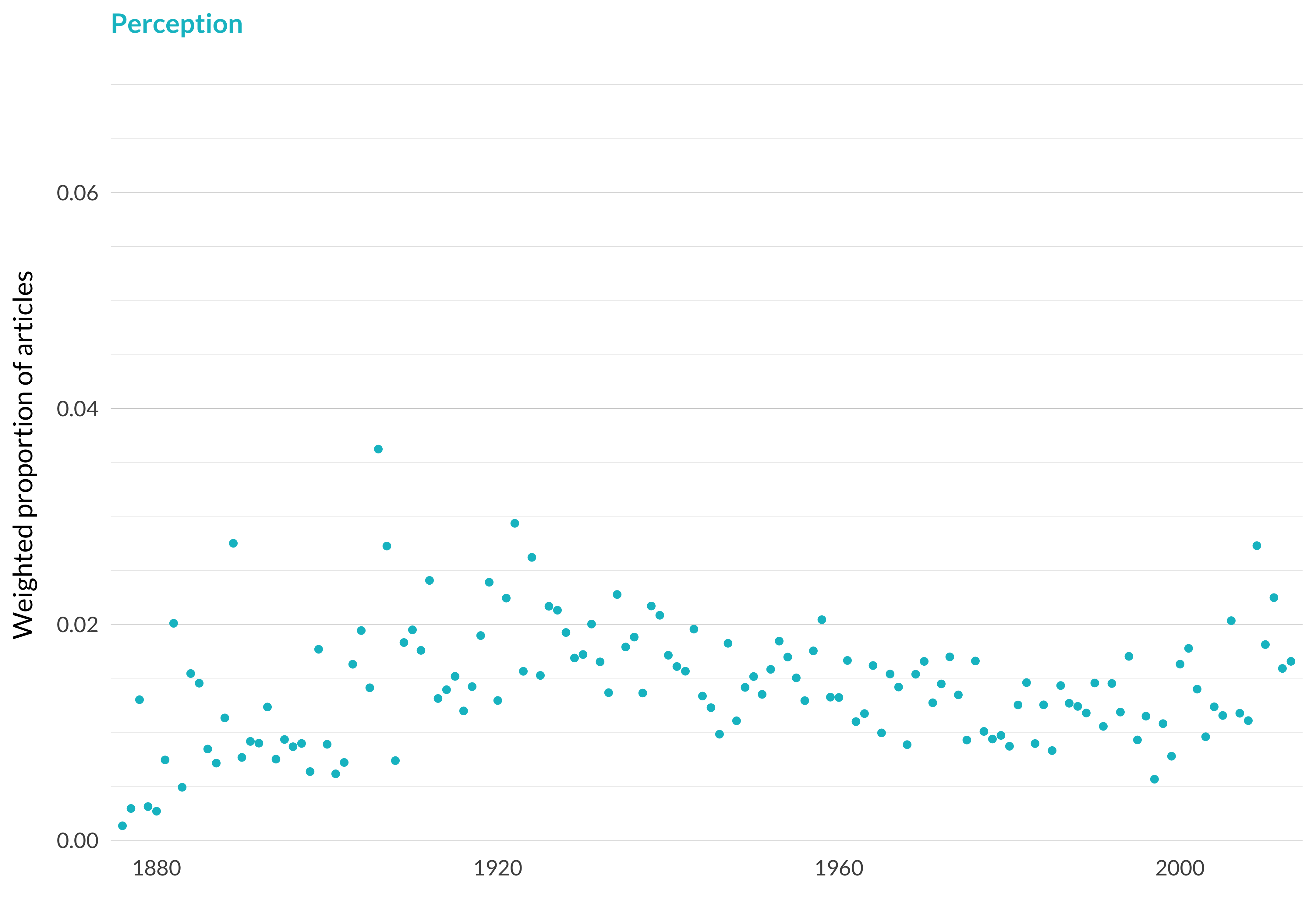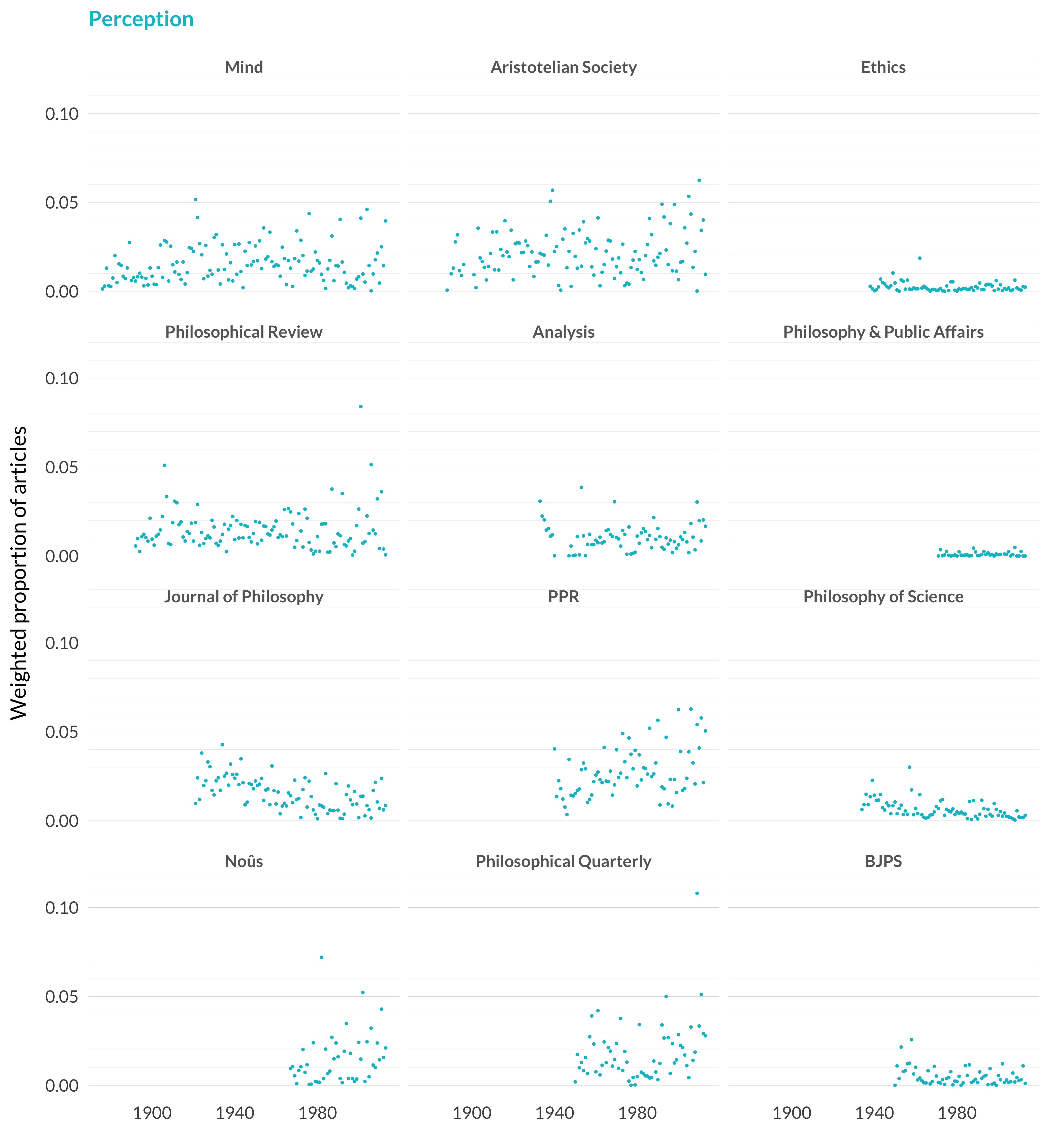2.47 Perception
Category: Philosophy of Mind
Keywords: perceiving, phenomenal, perceptual, perceive, experiences, perception, perceived, illusion, appearances, sensory, appearance, experience, experienced, awareness, visual
Number of Articles: 435
Percentage of Total: 1.4%
Rank: 20th
Weighted Number of Articles: 459.4
Percentage of Total: 1.4%
Rank: 16th
Mean Publication Year: 1977.9
Weighted Mean Publication Year: 1968.7
Median Publication Year: 1978
Modal Publication Year: 2009
Topic with Most Overlap: Ordinary Language (0.0607)
Topic this Overlaps Most With: Color/Colour (0.0549)
Topic with Least Overlap: Crime and Punishment (0.00014)
Topic this Overlaps Least With: Liberal Democracy (6e-04)

Figure 2.113: Perception.

Figure 2.114: Perception articles in each journal.
Comments
One can see from the facet graphs that perception has been a much bigger focus of some journals (e.g., Proceedings of the Aristotelian Society and Philosophy and Phenomenological Research) than others (e.g., Journal of Philosophy and Analysis). This sounds plausible to me, though it wasn’t something I had realized until running the study.
Perception has been a recurrent interest of philosophers throughout this period. It feels like there is something distinctive about this; very few topics have so much interest across such a long time. Here’s one way to test whether that is true. If something is discussed a lot over a long time, it should do well on a maximin measure—it should have a high lower bound. The data here is a bit noisy to trust that measure though; some wide-ranging topics might have a single down year. Instead I’ll use the following measure.
For each topic-year pair, I’ll look at what proportion of the articles in that year are in that topic. (Using weighted sums here, not raw sums.) Then within each topic I’ll rank the years from highest to lowest proportion. Then in those lists I’ll find the one hundredth highest (i.e., the thirty-ninth lowest) proportion. This should give us a pretty good breadth measure while filtering out some noise. And here is what we get if we rank the topics that way.
| Subject | Proportion |
|---|---|
| Ordinary Language | 0.0456767 |
| Methodology of Science | 0.0134248 |
| Perception | 0.0110876 |
| Life and Value | 0.0110664 |
| Moral Conscience | 0.0108404 |
| Deduction | 0.0107786 |
| Temporal Paradoxes | 0.0096332 |
| Other History | 0.0095311 |
| Physicalism | 0.0091159 |
| Propositions and Implications | 0.0090994 |
| Definitions | 0.0084410 |
| Value | 0.0083889 |
| Universals and Particulars | 0.0082952 |
| Chemistry | 0.0080676 |
| Idealism | 0.0079224 |
| Ontological Argument | 0.0074811 |
| Mechanisms | 0.0074576 |
| Promises and Imperatives | 0.0074524 |
| Classical Space and Time | 0.0072801 |
| Ancient | 0.0069733 |
| Self-Consciousness | 0.0067698 |
| Knowledge | 0.0066847 |
| Arguments | 0.0066431 |
| Early Modern | 0.0064934 |
| Meaning and Use | 0.0064569 |
| Dewey and Pragmatism | 0.0063303 |
| Laws | 0.0062690 |
| Time | 0.0061585 |
| Causation | 0.0061506 |
| Emotions | 0.0059598 |
| Truth | 0.0057124 |
| Faith and Theism | 0.0056697 |
| Mathematics | 0.0056401 |
| Marx | 0.0055739 |
| Kant | 0.0053905 |
| Color/Colour | 0.0052884 |
| Theories and Realism | 0.0051703 |
| Theory Testing | 0.0047831 |
| Beauty | 0.0047467 |
| Sets and Grue | 0.0045756 |
| Concepts | 0.0045341 |
| Social Contract Theory | 0.0043418 |
| Verification | 0.0043397 |
| Psychology | 0.0041158 |
| Analytic/Synthetic | 0.0040516 |
| Thermodynamics | 0.0040096 |
| Denoting | 0.0037719 |
| Freedom and Free Will | 0.0035181 |
| Origins and Purposes | 0.0034184 |
| Justification | 0.0033964 |
| History and Culture | 0.0033852 |
| Depiction | 0.0033295 |
| Minds and Machines | 0.0033140 |
| Chance | 0.0031436 |
| Personal Identity | 0.0030073 |
| Evolutionary Biology | 0.0029058 |
| Liberal Democracy | 0.0028868 |
| Functions | 0.0026067 |
| Reasons | 0.0025364 |
| Hume | 0.0025202 |
| Composition and Constitution | 0.0025054 |
| Duties | 0.0021904 |
| Decision Theory | 0.0021596 |
| Crime and Punishment | 0.0020734 |
| Wide Content | 0.0020339 |
| Space and Time | 0.0020323 |
| Explanation | 0.0018533 |
| Virtues | 0.0018358 |
| Intention | 0.0016462 |
| Feminism | 0.0015359 |
| Vagueness | 0.0014954 |
| War | 0.0014483 |
| Modality | 0.0013769 |
| Heidegger and Husserl | 0.0012365 |
| Speech Acts | 0.0011701 |
| Sense and Reference | 0.0010928 |
| Egalitarianism | 0.0010516 |
| Norms | 0.0010149 |
| Races and DNA | 0.0010118 |
| Medical Ethics and Freud | 0.0008414 |
| Abortion and Self-Defence | 0.0008067 |
| Frankfurt Cases | 0.0007888 |
| Game Theory | 0.0006747 |
| Cognitive Science | 0.0006617 |
| Quantum Physics | 0.0006180 |
| Radical Translation | 0.0006151 |
| Models | 0.0005722 |
| Belief Ascriptions | 0.0004314 |
| Population Ethics | 0.0004264 |
| Formal Epistemology | 0.0003254 |
And we get the result that perception is indeed a topic of continuing interest. The only ones ahead of it are ordinary language philosophy, which is a style as much as a topic, and methodology of science, which is obviously also something of continuiting interest to philosophers.
Most of the others are not surprising, except perhaps for life and value. Part of what this shows is that that topic isn’t quite as closely tied to idealism as it looks at first; it persists long after idealism falls away.